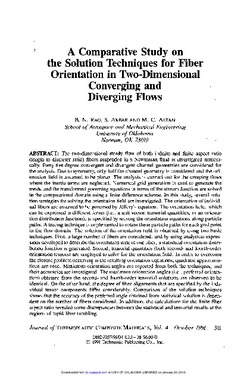| dc.contributor.author | B.N. Rao | |
| dc.contributor.author | S. Akbar | |
| dc.contributor.author | M.C. Altan | |
| dc.date.accessioned | 2016-01-14T19:53:17Z | |
| dc.date.accessioned | 2016-03-30T15:32:50Z | |
| dc.date.available | 2016-01-14T19:53:17Z | |
| dc.date.available | 2016-03-30T15:32:50Z | |
| dc.date.issued | 1991-10-01 | |
| dc.identifier.citation | Rao, B. N., Akbar, S., & Altan, M. C. (1991). A Comparative Study on the Solution Techniques for Fiber Orientation in Two-Dimensional Converging and Diverging Flows. Journal of Thermoplastic Composite Materials, 4(4), 311-348. doi: 10.1177/089270579100400402 | en_US |
| dc.identifier.uri | https://hdl.handle.net/11244/25171 | |
| dc.description.abstract | The two-dimensional steady flow of both infinite and finite aspect ratio (length to diameter ratio) fibers suspended in a Newtonian fluid is investigated numeri cally. Forty-five-degree convergent and divergent channel geometries are considered for the analysis. Due to symmetry, only half the channel geometry is considered and the ori entation field is assumed to be planar. The analysis is carried out for the creeping flows where the inertia terms are neglected. Numerical grid generation is used to generate the mesh, and the transformed governing equations in terms of the stream function are solved in the computational domain using a finite difference scheme. In this study, several solu tion strategies for solving the orientation field are investigated. The orientation of individ ual fibers are assumed to be governed by Jeffery's equation. The orientation field, which can be expressed in different forms (i.e., a unit vector, tensorial quantities, or an orienta tion distribution function), is specified by solving the orientation equations along particle paths. A tracing technique is implemented to obtain these particle paths for each grid point in the flow domain. The solution of the orientation field is obtained by using two basic techniques. First, a large number of fibers are considered, and by using analytical expres sions developed to describe the orientation state of one fiber, a statistical orientation distri bution function is generated. Second, tensorial quantities (both second- and fourth-order orientation tensors) are employed to solve for the orientation field. In order to overcome the closure problem occurring in the resulting orientation equations, quadratic approxima tions are used. Maximum orientation angles are reported from both the techniques, and their accuracies are investigated. The maximum orientation angles (i.e., preferred orienta tion) obtained from the second- and fourth-order tensorial solutions are observed to be identical. On the other hand, the degree of fiber alignments that are specified by the indi vidual tensor components differ considerably. Comparison of the solution techniques shows that the accuracy of the preferred angle obtained from statistical solution is depen dent on the number of fibers considered. In addition, the calculations for the finite fiber aspect ratio revealed some discrepancies between the statistical and tensorial results at the regions of rapid fiber tumbling. | en_US |
| dc.language.iso | en_US | en_US |
| dc.publisher | Journal of Thermoplastic Composite Materials | |
| dc.title | A Comparative Study on the Solution Techniques for Fiber Orientation in Two-Dimensional Converging and Diverging Flows | en_US |
| dc.type | Research Article | en_US |
| dc.description.peerreview | Yes | en_US |
| dc.description.peerreviewnotes | https://us.sagepub.com/en-us/nam/manuscript-submission-guidelines | en_US |
| dc.identifier.doi | 10.1177/089270579100400402 | en_US |
| dc.rights.requestable | false | en_US |
